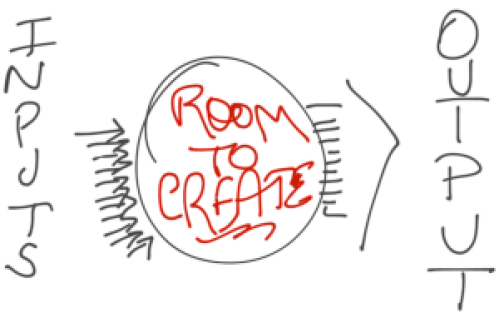Probably the only concept I still remember from when I programmed in Basic was this:
Everything is a series of inputs, or outputs.
Inputs are the signals or data received by the system, and outputs are the signals or data sent from it. Business can be seen as a series of inputs and outputs, too. Bodies, quite literally, work like this.
So I’ve been pretty intentional about making sure I have good inputs. By attending well-curated conferences (like TED), hanging out with creative, inspiring, and thoughtful people, listening for good questions to steer writing, signing up to receive the writing of great thinkers who blog, taking time to read outside one’s domain, and traveling to foreign places, reading good books (did you see the post on Peter Sims book), etc.
You probably have a similar list for how to have great inputs.
Lately, I am disappointed with my outputs. I sense that something is missing. And so, I started thinking of how to add more or different inputs. I neglected to think of the system view for a moment.
But it is obvious when I think of it: inputs and outputs are typically what we can see. But the important part is that there is something happen by the system to the inputs to create outputs. Inputs are not an end into itself; they are a beginning. To be changed by the inputs, there has to be space to create, to build on the input, and then to produce an output. The system itself has to do something to the inputs to create meaningful value. We know that cells need to regenerate. We know machines needs to compute. Well, humans need to create.
To create, we need space to do so, often in the form of silence and time. Time allows what we do not just be a production line of emails and meetings. And, space enables each of us create a more thoughtful point of view. It’s the different between being a consumer and processes of information, and being a creator of insights. Humans need to create; that’s what the system is designed to do. But only if we let it.





I think you have two threads coalesced here: process and environment. The places where our work goes on and the people we come in contact with (and, as a result, their ideas) have a tremendous influence on our productivity and the quality of our work. That’s one reasons aspiring HS students work so hard to get into Ivy League schools: there’s a dramatic difference between the environment and the people you can surround yourself with at State U and at Harvard!Process too is a powerful determinant of output. Good process can lead to very positive outcomes; bad process can ruin an outcome and undo the best efforts of very capable people. The classic example mgmt types study took place during the Kennedy administration: the Bay of Pigs Invasion vs. the Cuban Missile Crisis. The difference between these two scenarii was process, and it all came back to the advice of President Eisenhower (who had some experience with decision-making back in WWII). Kennedy consulted him after the first, which didn’t go well, and the second outcome was dramatically different primarily because it went through a different process.
A brief comment since I happen to be at a computer here in Ages, Castilla.A lot of people write like this– they have this tiny insight and they say "reminder! this is an insight, and here, it's relevant in this way, etc." it's kind of Seth Godin like, and since his blog is popular the style has sort of spread all over the place. Anyway I don't really think this is wrong or anything, just that it's sort of… mundane or something. This post could be pushed quite a few different ways, and that's how I like to think of work that I do– how can it be pushed further, etc. So here, with this, I'd tell a story of how cells regenerate, by saying "i broke my arm, then when i ate well, it healed faster," and then i'd relate that to how input relates to output.btw, i'm sending you this because you asked me to send you tips about your blog. does this help?
Julien – You are a gem. I will think more about how to be more specific and then to push the idea more into a specific direction. Not sure exactly what that looks like so let me play with it a bit. As always, a student, Nilofer
Nilopher – This is great and this triggers so many thoughts! I too have been thinking about this as I am running my job campaign. Some inputs we create as we consciously place ourselves in situations and pursue opportunities. And some inputs just happen for us as we go about our day. Certainly all that matters, but also having a background in art and a career in marketing/strategy, I find what one really has some influence, or even control of, is how we create our “room to create”. How we choose to weave and lattice the inputs together and then present those outputs is a space where I find I need to exercise patience with myself and others. Sell no wine before it’s time.